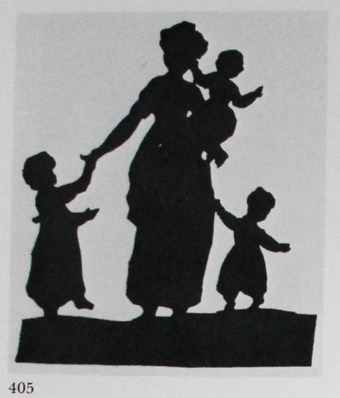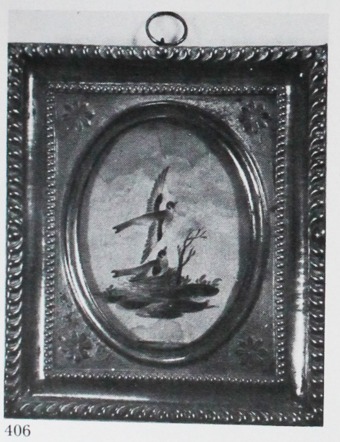Elizabeth, Princess (McKechnie Section 1)
Princess Elizabeth, the seventh child and fourth daughter of George III and Queen Charlotte, was born in 1770. That she had precocious talent as an artist is demonstrated by the reproduction, as the frontispiece of the Westminster Magazine, December 1781, of a profile of her father which she must have cut when she was little more than ten years old. This must be a very early instance of a print being taken from a silhouette. The leading editorial article in the issue was headed:
EULOGY ON HIS PRESENT MAJESTY
(Embellished with a whole-length STRIKING LIKENESS OF HIM, executed in a manner never attempted in any Magazine before)
The article contained a brief excerpt from a poem by Ben Jonson:
Princes that would their people shou'd do well,
Must at themselves begin, as at the head;
For men by their example pattern out
Their imitations, and regard of laws;
A virtuous court a world to virtue draws.
In 1795 the Princess designed a series of pictures entitled 'The Birth and Triumph of Cupid'. Mrs Foskett considers that some of the Princess's painted work shows the influence of the miniature-painter Mrs Mee.
In 1808 Princess Elizabeth established in Windsor a society for giving dowries to poor girls. In 1817 she accompanied Queen Charlotte to Bath (where they lived for a short time at a house in Sydney Place), and in the following year she married Frederick Joseph Louis, the hereditary Prince of Hesse-Homburg, thus becoming the Landgravine of Hesse-Homburg.
In Hesse-Homburg, the Princess set apart what was then the large sum of £6,000 a year from her own income to help reduce the deficits of that state and to benefit the poor. To assist in the latter object, she reissued in Hamburg in 1832 a set of engravings of her series of sketches, 'Power and Progress of Genius'. Princess Elizabeth died in Frankfurt at the age of seventy on 10 January 1840, in the same year as her elder sister, Princess Augusta.
The Princess cut some genre pieces and other pieces in the silhouette technique, which she assembled in a small album, measuring 7 x 54 in., bound in blue morocco leather and closed with a silver clasp. She gave this album to Lady Banks, one of the Ladies in Waiting at Court. Later it passed into the hands of Lady Dorothy Nevin, and it is now in the Royal Collection. Some of the Princess's profiles, a number of which depict scenes of family life, may have been inspired by, or may even represent, her younger brothers and sisters, of whom there were eight. The three youngest of them died young. These were Prince Octavius (the eighth son, who was born in 1779 and died in 1783, after an inoculation for a cold). Prince Alfred (who, born in 1780, was always an ailing child and died in 1782), and the youngest of the family, the Princess Amelia (who was born in 1783 and died in 1810). It is interesting to note that three prints of profiles of George III and one of Queen Charlotte, included in this album with the Princess's own work, have now been identified as the work of Dr James Lind (q.v.).
Princess Elizabeth's genre pieces are full of character and animation. All the authenticated examples of the Princess's work as a profilist are in the Royal Collection, and it seems unlikely that any other original profiles by her (as opposed to prints of them, such as the print which was published in the Westminster Magazine) will be discovered. There is a portrait miniature by the Princess, representing Lady Charlotte Finch, in the Royal Collection; it is illustrated by Mrs Foskett.
I have illustrated, as a matter of interest, a small painting of goldfinches which has been authenticated as the work of one of George Ill's daughters: possibly Princess Elizabeth.
Ills. 404-406

George III. Print after a silhouette cut by Princess Elizabeth, reproduced as frontispiece to the Westminster Magazine, December 1781.
Author’s collection

Cut silhouettes by Princess Elizabeth. Examples of genre work by the Princess, from the album in the Royal Collection at Windsor Castle.
By gracious permission of Her Majesty the Queen

Goldfinches.
Water-colour by one of George III’s daughters, possibly Princess Elizabeth. The painting is inscribed on the back, ‘Painted by one of the daughters of George III and given by her to her nurse, Miss Mary Brown of Stanley or Sunley, who gave it to me. D. E. Oates, fordingbridge’.
Author’s collection
